It’s 2011 — NASA’s Year of the Solar System! Join us on a cosmic road trip to explore solar system mysteries and share in the thrill of discovery at an exciting new workshop for educators of all grade levels.
NASA’s Discovery and New Frontiers missions are traveling vast distances to find answers to age-old questions. These celestial detectives are revealing how our solar system formed and evolved, doing brilliant science with “way cool” technologies!
• See sights never before seen on Mercury: MESSENGER!
• Get up close to asteroids and comets: Dawn, Stardust-NExT and EPOXI!
• Map the moon’s gravity with twin satellites: GRAIL!
• Peer through Jupiter’s clouds: Juno!
• Cruise to the outer reaches of the solar system: New Horizons!
Hear from mission scientists and engineers, discover engaging activities for grades K-12 classrooms and out-of-school time programs, and receive a resource book loaded with activities and links.
Details
When: Saturday, March 19, 9 a.m. to 2 p.m. at each location listed below.
Where:
• NASA’s Jet Propulsion Laboratory, Pasadena, Calif.
• NASA’s Johnson Space Center, Houston, Texas.
• Jackson Middle School Observatory, Champlin, Minn.
• Johns Hopkins University Applied Physics Laboratory, Laurel, Md.
Cost: $25 (lunch and snacks included).
Special Speakers
- Six years after launch, MESSENGER will enter orbit around Mercury on March 18. We are very fortunate to have Dr. Sean Solomon, MESSENGER’s Principal Investigator, tell us about the mission’s goals, the science findings so far, and the excitement of reaching the orbiting phase of the mission.
- The Dawn mission uses ion propulsion to visit the two largest objects in the asteroid belt. Launched in September 2007, Dawn will arrive at asteroid Vesta this July for a year-long orbit. Dawn’s Chief Engineer, Dr. Marc Rayman, will share why this mission is so unique and what scientists hope to learn.
- Juno’s quest is to aid in the understanding of the formation and evolution of Jupiter, which will help us comprehend the origin of the entire solar system. Juno will launch this August. Dr. Ravit Helled from the gravity team tells us how Juno will reveal “the giant planet story.”
Watch the speakers on the free webinar if you can’t be at one of the sites.
 The Moderate Resolution Imaging Spectroradiometer, or MODIS, on NASA’s Aqua satellite and the MODIS sensor on NASA’s Terra satellite took photos of Japan’s earthquake and tsunami. Images were made with infrared and visible light to highlight the presence of water and other features on the ground.
The Moderate Resolution Imaging Spectroradiometer, or MODIS, on NASA’s Aqua satellite and the MODIS sensor on NASA’s Terra satellite took photos of Japan’s earthquake and tsunami. Images were made with infrared and visible light to highlight the presence of water and other features on the ground.
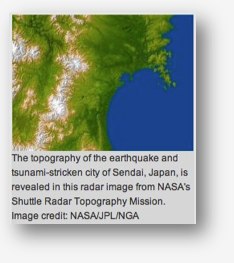 The March 11, magnitude 9.0 earthquake in Japan may have shortened the length of each Earth day and shifted its axis. But don’t worry—you won’t notice the difference.
The March 11, magnitude 9.0 earthquake in Japan may have shortened the length of each Earth day and shifted its axis. But don’t worry—you won’t notice the difference. In 2008-2009, sunspots almost completely disappeared for two years. Solar activity dropped to hundred-year lows; Earth’s upper atmosphere cooled and collapsed; the sun’s magnetic field weakened, allowing cosmic rays to penetrate the Solar System in record numbers. It was a big event, and solar physicists openly wondered, where have all the sunspots gone?
In 2008-2009, sunspots almost completely disappeared for two years. Solar activity dropped to hundred-year lows; Earth’s upper atmosphere cooled and collapsed; the sun’s magnetic field weakened, allowing cosmic rays to penetrate the Solar System in record numbers. It was a big event, and solar physicists openly wondered, where have all the sunspots gone?  Next month, MESSENGER will execute a 15-minute maneuver. placing the spacecraft into orbit around Mercury. It will be the first spacecraft ever to orbit the solar system’s innermost planet. Check out the MESSENGER module
Next month, MESSENGER will execute a 15-minute maneuver. placing the spacecraft into orbit around Mercury. It will be the first spacecraft ever to orbit the solar system’s innermost planet. Check out the MESSENGER module 
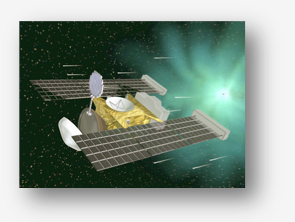 On Feb. 14, 2011, NASA’s Stardust-NExT (New Exploration of Tempel 1) mission will encounter Comet Tempel 1, providing a unique opportunity to measure the dust properties of two separate comets (Wild 2 and Tempel 1) with the same instrument for accurate data comparison. The encounter also will provide a comparison between two observations of a single comet, Tempel 1, taken before and after a single orbital pass around the sun.
On Feb. 14, 2011, NASA’s Stardust-NExT (New Exploration of Tempel 1) mission will encounter Comet Tempel 1, providing a unique opportunity to measure the dust properties of two separate comets (Wild 2 and Tempel 1) with the same instrument for accurate data comparison. The encounter also will provide a comparison between two observations of a single comet, Tempel 1, taken before and after a single orbital pass around the sun.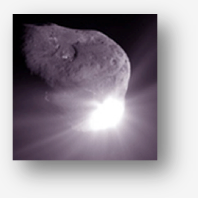 NASA’s Deep Impact mission observed Comet Tempel 1 in the summer of 2005, as the comet was inbound toward the sun on its approximately 5.5-year orbit between Mars and Jupiter. Deep Impact’s primary mission was to deliver a special impactor spacecraft into the path of Comet Tempel 1. The spacecraft — and many ground-based observers — observed the impact and the ejected material. Scientists were surprised the cloud was composed of a fine, powdery material, not the expected water, ice and dirt. The spacecraft did find the first evidence of surface ice on a comet instead of just inside a comet.
NASA’s Deep Impact mission observed Comet Tempel 1 in the summer of 2005, as the comet was inbound toward the sun on its approximately 5.5-year orbit between Mars and Jupiter. Deep Impact’s primary mission was to deliver a special impactor spacecraft into the path of Comet Tempel 1. The spacecraft — and many ground-based observers — observed the impact and the ejected material. Scientists were surprised the cloud was composed of a fine, powdery material, not the expected water, ice and dirt. The spacecraft did find the first evidence of surface ice on a comet instead of just inside a comet.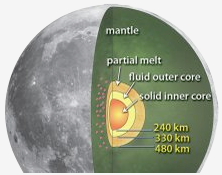 Are you looking for an extension for the Lunar Surface Instrumentation Content Module on the NASA Explorer Schools Virtual Campus? Bring current NASA discoveries into your classroom with this article!
Are you looking for an extension for the Lunar Surface Instrumentation Content Module on the NASA Explorer Schools Virtual Campus? Bring current NASA discoveries into your classroom with this article!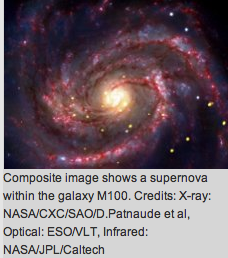 Astronomers using NASA’s Chandra X-ray Observatory have found evidence of the youngest black hole known to exist in our cosmic neighborhood. The 30-year-old object provides a unique opportunity to watch a black hole develop from infancy.
Astronomers using NASA’s Chandra X-ray Observatory have found evidence of the youngest black hole known to exist in our cosmic neighborhood. The 30-year-old object provides a unique opportunity to watch a black hole develop from infancy.